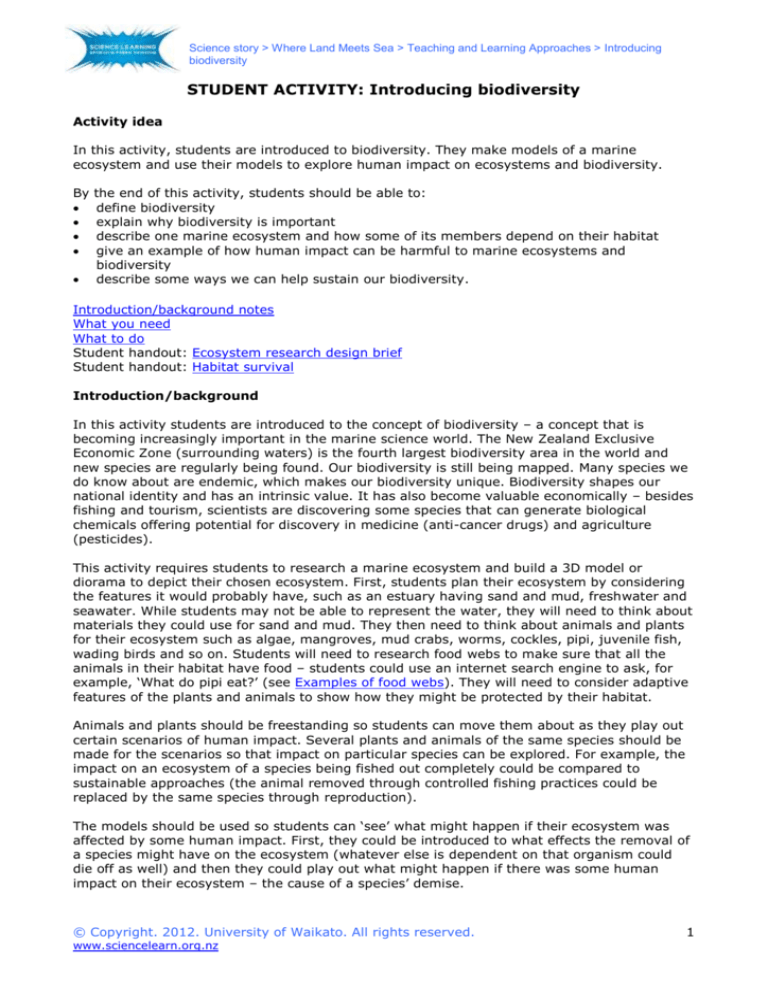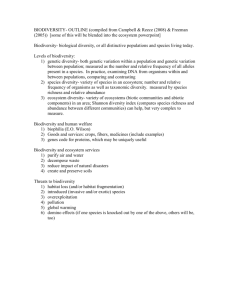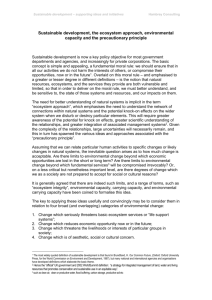
Science story > Where Land Meets Sea > Teaching and Learning Approaches > Introducing
biodiversity
STUDENT ACTIVITY: Introducing biodiversity
Activity idea
In this activity, students are introduced to biodiversity. They make models of a marine
ecosystem and use their models to explore human impact on ecosystems and biodiversity.
By
the end of this activity, students should be able to:
define biodiversity
explain why biodiversity is important
describe one marine ecosystem and how some of its members depend on their habitat
give an example of how human impact can be harmful to marine ecosystems and
biodiversity
describe some ways we can help sustain our biodiversity.
Introduction/background notes
What you need
What to do
Student handout: Ecosystem research design brief
Student handout: Habitat survival
Introduction/background
In this activity students are introduced to the concept of biodiversity – a concept that is
becoming increasingly important in the marine science world. The New Zealand Exclusive
Economic Zone (surrounding waters) is the fourth largest biodiversity area in the world and
new species are regularly being found. Our biodiversity is still being mapped. Many species we
do know about are endemic, which makes our biodiversity unique. Biodiversity shapes our
national identity and has an intrinsic value. It has also become valuable economically – besides
fishing and tourism, scientists are discovering some species that can generate biological
chemicals offering potential for discovery in medicine (anti-cancer drugs) and agriculture
(pesticides).
This activity requires students to research a marine ecosystem and build a 3D model or
diorama to depict their chosen ecosystem. First, students plan their ecosystem by considering
the features it would probably have, such as an estuary having sand and mud, freshwater and
seawater. While students may not be able to represent the water, they will need to think about
materials they could use for sand and mud. They then need to think about animals and plants
for their ecosystem such as algae, mangroves, mud crabs, worms, cockles, pipi, juvenile fish,
wading birds and so on. Students will need to research food webs to make sure that all the
animals in their habitat have food – students could use an internet search engine to ask, for
example, ‘What do pipi eat?’ (see Examples of food webs). They will need to consider adaptive
features of the plants and animals to show how they might be protected by their habitat.
Animals and plants should be freestanding so students can move them about as they play out
certain scenarios of human impact. Several plants and animals of the same species should be
made for the scenarios so that impact on particular species can be explored. For example, the
impact on an ecosystem of a species being fished out completely could be compared to
sustainable approaches (the animal removed through controlled fishing practices could be
replaced by the same species through reproduction).
The models should be used so students can ‘see’ what might happen if their ecosystem was
affected by some human impact. First, they could be introduced to what effects the removal of
a species might have on the ecosystem (whatever else is dependent on that organism could
die off as well) and then they could play out what might happen if there was some human
impact on their ecosystem – the cause of a species’ demise.
© Copyright. 2012. University of Waikato. All rights reserved.
www.sciencelearn.org.nz
1
Science story > Where Land Meets Sea > Teaching and Learning Approaches > Introducing
biodiversity
Students may wish to make models of sediment and types of pollution to show what would
happen to the biodiversity if the pollution entered the ecosystem. Coloured dots could be
added to animals to represent heavy metals and polycyclic aromatic hydrocarbons (PAHs)
ingested by them. One dot could mean the animal is sick and doesn’t feed well, two dots
means it doesn’t feed well or reproduce, three dots means the animal is dead. Students could
describe these events when they talk about their scenario.
Examples of food webs
Estuarine food web
www.niwa.co.nz/education-and-training/schools/students/estuaries#whatenc
Rocky shore food web
http://w3.shorecrest.org/~Lisa_Peck/MarineBio/syllabus/ch11_ecosystems/ecosystem_wp/
Rockyshores_jake_ashleyh/foodweb.html
Sandy beach food web
http://w3.shorecrest.org/~Lisa_Peck/MarineBio/syllabus/ch11_ecosystems/ecosystem_wp/
sandybeach_kristen_eric/foodweb.html
What you need
Access to Biodiversity in the Bay of Plenty, Habitats in the Bay of Plenty, Adapting to
marine habitats, Human impacts on the Bay of Plenty, Resilience to stress and Pollution
from Rena
Copies of the student handout Ecosystem research design brief
Copies of the student handout Habitat survival
Materials for 3D models or dioramas, such as cardboard, shoeboxes, images of animals and
plants, modelling clay, sponge, polystyrene, cloth, sand, paint, coloured pencils, Blu-Tack
What to do
1. In pairs, have students work out what biodiversity means by obtaining the dictionary
meaning for ‘bio’ and ‘diversity’. As a class, discuss a possible definition for biodiversity.
2. Read Biodiversity in the Bay of Plenty in pairs or small groups. Discuss the importance of
biodiversity as a class.
3. Hand out copies of the student handouts Ecosystem research design brief and Habitat
survival (students will need several copies of this) and discuss. Explain that each group
needs to create a 3D model or diorama of a selected marine ecosystem (coastal beach,
estuary, rocky shore or offshore island):
The design should show as many features of the ecosystem as possible including
appropriate aquatic plants and animals.
Make sure the animals in your habitat all have something to eat and have some form of
protection (for example, they can burrow into the sand to hide). Also be aware of where
in your habitat your animal lives (for example, shellfish live in sand or mud on the
seafloor).
Try to make the animals and plants freestanding so that they can be moved around.
Make several animals and plants of the same species (for example, a number of algae
plants and a number of tuatua and so on).
4. Before students start their model, they should:
read Habitats in the Bay of Plenty and Adapting to marine habitats
use the internet to research their New Zealand marine ecosystem to find out what it
might contain and how organisms survive in that ecosystem
complete the student handout Ecosystem research design brief
complete the student handout Habitat survival – they need one oval for each animal
show the teacher their completed handouts.
© Copyright. 2012. University of Waikato. All rights reserved.
www.sciencelearn.org.nz
2
Science story > Where Land Meets Sea > Teaching and Learning Approaches > Introducing
biodiversity
5. Have students compare their group’s model to a different ecosystem model. How are they
different? How are they the same?
6. Read and discuss Human impacts on the Bay of Plenty, Resilience to stress and Pollution
from Rena.
7. Have student groups use their model to play out various scenarios:
What would happen if all of one species was fished out?
Remove one species from your ecosystem. How would it affect your ecosystem?
What happens to the animals that eat the species you have removed?
Remove another species. What are the effects on the whole ecosystem?
What would happen if you added something detrimental to your ecosystem such as
sediment or pollution – poisons like heavy metals and PAHs or oil from ships? What
would this affect immediately? What else might happen to your ecosystem?
Think of some other scenarios that could impact on your ecosystem.
8. Have each group choose one scenario (a human impact) to show the class. Group members
take turns to describe and show events happening in their ecosystem.
9. Discuss in groups or as a class how people could help to protect biodiversity in marine
ecosystems.
© Copyright. 2012. University of Waikato. All rights reserved.
www.sciencelearn.org.nz
3
Science story > Where Land Meets Sea > Teaching and Learning Approaches > Introducing
biodiversity
Student handout: Ecosystem research design brief
Research, design and make a 3D model or a diorama of a New Zealand marine ecosystem (an
estuary, coastal beach or rocky shore) that can be used to explain biodiversity to people.
Features: What ecosystem features will you
include?
Plants and animals: What plants and
animals will you include?
Materials: List all the materials that you will
use to make your model/diorama.
Equipment: List all the equipment that you
will use to make your model/diorama.
Using your model: Describe how you could use your model to promote the importance of
biodiversity to people and the importance of caring for our ecosystems.
Drawing: On the next page, sketch your design – label features, animals and plants.
© Copyright. 2012. University of Waikato. All rights reserved.
www.sciencelearn.org.nz
4
Science story > Where Land Meets Sea > Teaching and Learning Approaches > Introducing
biodiversity
Drawing: Sketch your design – label features, animals and plants.
© Copyright. 2012. University of Waikato. All rights reserved.
www.sciencelearn.org.nz
5
Science story > Where Land Meets Sea > Teaching and Learning Approaches > Introducing
biodiversity
Student handout: Habitat survival
It lives in/on
It eats
The animal is
It is eaten by
______________________
It lives in/on
It is protected by
It eats
The animal is
It is eaten by
______________________
It lives in/on
It is protected by
It eats
The animal is
It is eaten by
______________________
© Copyright. 2012. University of Waikato. All rights reserved.
www.sciencelearn.org.nz
It is protected by
6










